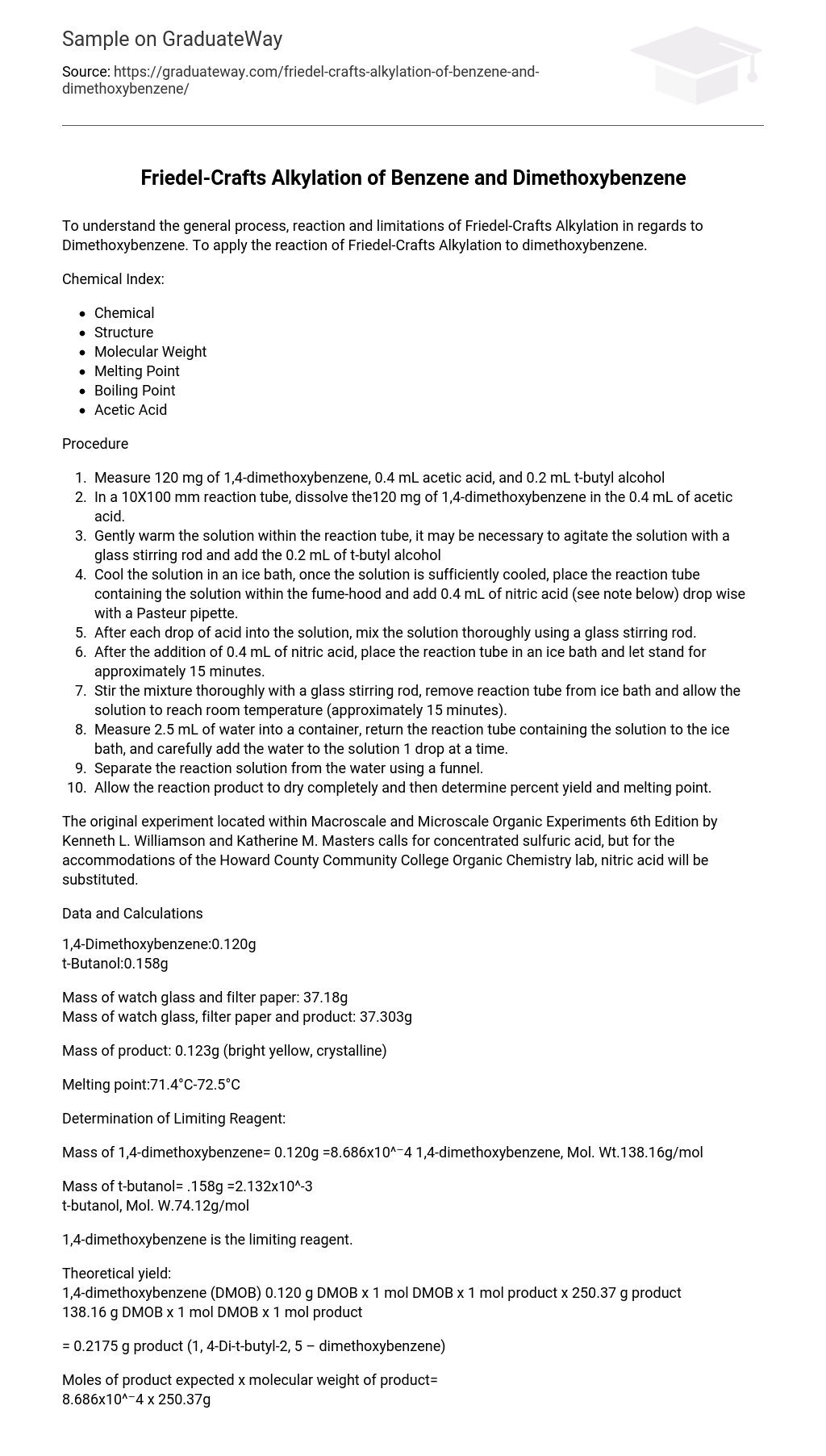To understand the general process, reaction and limitations of Friedel-Crafts Alkylation in regards to Dimethoxybenzene. To apply the reaction of Friedel-Crafts Alkylation to dimethoxybenzene.
Chemical Index:
- Chemical
- Structure
- Molecular Weight
- Melting Point
- Boiling Point
- Acetic Acid
Procedure
- Measure 120 mg of 1,4-dimethoxybenzene, 0.4 mL acetic acid, and 0.2 mL t-butyl alcohol
- In a 10X100 mm reaction tube, dissolve the120 mg of 1,4-dimethoxybenzene in the 0.4 mL of acetic acid.
- Gently warm the solution within the reaction tube, it may be necessary to agitate the solution with a glass stirring rod and add the 0.2 mL of t-butyl alcohol
- Cool the solution in an ice bath, once the solution is sufficiently cooled, place the reaction tube containing the solution within the fume-hood and add 0.4 mL of nitric acid (see note below) drop wise with a Pasteur pipette.
- After each drop of acid into the solution, mix the solution thoroughly using a glass stirring rod.
- After the addition of 0.4 mL of nitric acid, place the reaction tube in an ice bath and let stand for approximately 15 minutes.
- Stir the mixture thoroughly with a glass stirring rod, remove reaction tube from ice bath and allow the solution to reach room temperature (approximately 15 minutes).
- Measure 2.5 mL of water into a container, return the reaction tube containing the solution to the ice bath, and carefully add the water to the solution 1 drop at a time.
- Separate the reaction solution from the water using a funnel.
- Allow the reaction product to dry completely and then determine percent yield and melting point.
The original experiment located within Macroscale and Microscale Organic Experiments 6th Edition by Kenneth L. Williamson and Katherine M. Masters calls for concentrated sulfuric acid, but for the accommodations of the Howard County Community College Organic Chemistry lab, nitric acid will be substituted.
Data and Calculations
1,4-Dimethoxybenzene:0.120g
t-Butanol:0.158g
Mass of watch glass and filter paper: 37.18g
Mass of watch glass, filter paper and product: 37.303g
Mass of product: 0.123g (bright yellow, crystalline)
Melting point:71.4°C-72.5°C
Determination of Limiting Reagent:
Mass of 1,4-dimethoxybenzene= 0.120g =8.686×10^⁻4 1,4-dimethoxybenzene, Mol. Wt.138.16g/mol
Mass of t-butanol= .158g =2.132×10^-3
t-butanol, Mol. W.74.12g/mol
1,4-dimethoxybenzene is the limiting reagent.
Theoretical yield:
1,4-dimethoxybenzene (DMOB) 0.120 g DMOB x 1 mol DMOB x 1 mol product x 250.37 g product
138.16 g DMOB x 1 mol DMOB x 1 mol product
= 0.2175 g product (1, 4-Di-t-butyl-2, 5 – dimethoxybenzene)
Moles of product expected x molecular weight of product=
8.686×10^⁻4 x 250.37g/mol = 0.2175g theoretical yield
Actual percent yield:
Grams of product x 100 % =
Theoretical yield
0.123 x 100% = 0.566 x 100% = 56.6%
0.2175
Results and Discussion
In this experiment, dimethoxybenzene reacted with t-butanol in a Friedel-Crafts Alkylation reaction (using nitric acid as the catalyst) in order to theoretically produce 1, 4-Di-t-butyl-2, 5-dimethoxybenzene. Through this process a product of 56.5% was achieved. The bright yellow crystallized product was analyzed to achieve a melting point of 71.4°C-72.5°C. These results are slightly problematic for two reasons; the actual percentage yield (which is actually greater than the theoretical percentage yield of 21.8%) is only 56.6%, and the melting point deviate from the melting point recorded by the Material Safety Data Sheet of 104 – 105°C. The deviations in results both of the actual percentage yield vs. the theoretical percentage yield and the melting point can be accounted for by inherent impurities in the tested chemicals, and also a loss of product throughout the reaction process.
It is likely that throughout the reaction process the chemical samples used will be introduced to various contaminates, either through the extraction of a chemical from its original container (due to multiple lab groups extracting from the same source) and also through exposure to the lab environment before its testing, which will allow the chemical to deviate from specific analytical data. For instance, the melting point determined through this lab was 71.4°C-72.5°C, but the MSDS for 1, 4-Di-t-butyl-2, 5-dimethoxybenzene was 104 – 105°C. The considerably lower melting point temperature can be explained through inherent impurities within the product. Although the product was allowed to dry for a couple days, it was never washed with a solvent such as methanol to reduce the impurities within the product. The loss of 43.4% of the entire product can largely be attributed to a flaw within the process of the experiment. The major flaw in the process occurred when the product was extracted from the reaction tube, although the tube was rinsed twice with water it is almost impossible to transport the entirety of the crystal product.
Further more, I was unable to ascertain the exact chemical composition of the product because NMR (nuclear mas resonance spectrometry) was never conducted. Thus, it is impossible to determine whether or not the product is actually 1, 4-Di-t-butyl-2, 5 – dimethoxybenzene and that the reaction was successful. Without further analysis it is impossible to determine whether or not the Friedel-Crafts alkylation reaction and the experiment were successful.
If this experiment were to be repeated in order to compare the results to the previously conducted experiment, it would be suggested that the procedure explicitly adhere to the procedure outlined by the text book, Macroscale and Microscale Organic Experiments 6th Edition by Kenneth L. Williamson and Katherine M. Masters. By adhering to this procedure, it would likely reduce both the amount of impurities present within the supplied chemicals, and also aid in the recovery of the product.
References
- Williamson, Kenneth L., and Katherine M. Masters. Macroscale and Microscale Organic Experiments. 6th ed. N.p.: n.p., n.d. Print.
- “Benzene,1,4-di-tert-butyl-2,5-dimethoxy- (7CI,8CI);1,4-Di-tert-butyl-2,5-dimethoxybenzene;1,4-Dimethoxy-2,5-di-tert-butylbenzene… Dictionary – Guidechem.com.” Benzene,1,4-di-tert-butyl-2,5-dimethoxy- (7CI,8CI);1,4-Di-tert-butyl-2,5-dimethoxybenzene;1,4-Dimethoxy-2,5-di-tert-butylbenzene… Dictionary – Guidechem.com. N.p., n.d. Web. 3 Sept. 2013.





